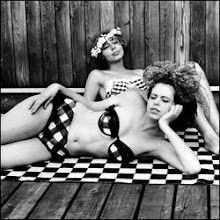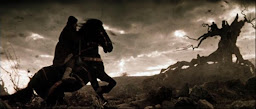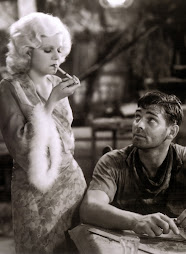 Claire Trevor, born March 8, 1910, in Brooklyn, New York. The "Queen of Film Noir." Born Claire Wemlinger, both of her parents were immigrants. Her father was from Paris and worked as a tailor in his business on 5th Avenue; her mother was from Belfast. She attended the American Academy of Dramatic Arts and then began a stage career. Her career in films started right in her own backyard at the Warner Bros.-owned Vitaphone Studios in Brooklyn.
Claire Trevor, born March 8, 1910, in Brooklyn, New York. The "Queen of Film Noir." Born Claire Wemlinger, both of her parents were immigrants. Her father was from Paris and worked as a tailor in his business on 5th Avenue; her mother was from Belfast. She attended the American Academy of Dramatic Arts and then began a stage career. Her career in films started right in her own backyard at the Warner Bros.-owned Vitaphone Studios in Brooklyn.By the early thirties she was in Hollywood, and it didn't take long for Warner Bros. to start her in the roles she would make a career of: the floozie, the hooker with a heart of gold, the gangster's moll, the femme fatale. She earned a Best Supporting Actress nomination for her role as a young girl who turns to prostitutuion in 1937's Dead End (dir. William Wyler). She was nominated again in 1949 for John Huston's Key Largo and won. It's still a chilling performance. The scene where Edward G. Robinson's ganster forces her to sing for a drink is almost too painful to watch. Huston knew Trevor wasn't much of a singer and that she was nervous about doing the scene. If I remember the anecdote correctly, she had wanted someone to dub her voice and Huston had at first agreed. But then on the day of shooting he told her no, she'd be singing herself and they wouldn't dub her voice, and this caused Trevor to be so nervous and tense that her performance in the scene was less actual acting and more real terror. But I don't care. Acting or for real, her ability to be so honest and raw in that scene (and really, thoughout the movie) gave us one of the greatest supporting performances ever put to celluloid.
This was her gift. The bad girls, the low-lifes, the women who just couldn't get anywhere in life: no one could give them the humanity and the depth that Claire Trevor could. Even at her most fatale, she could still make you see the good girl underneath, even if that good girl was only a faded imprint on an image of all black.
She was nominated by the Academy again in 1954 for The High and the Mighty. She was also nominated twice for an Emmy, and won the award in 1954 for her role in the television production of Dodsworth.
Her Oscar and Emmy statues now reside at the University of California, Irvine (Go 'Eaters!), Claire Trevor School of the Arts. Having an arts school named after Dallas from Stagecoach? Pretty darn cool. And that's what Claire Trevor, the Queen of Film Noir was: Pretty darn cool.

Barbara Stanwyck, born July 16, 1907, in New York City. Little Ruby Stevens had a pretty tough life growing up in Brooklyn. Only two years old when her mother died, and not much older than that when her father abandoned the family, little Ruby was raised in foster homes and by her older sister. By fifteen she was a Ziegfeld Girl.
Stanwyck wasn't always one of my favorites. In my early days of classic film watching, the only thing I'd seen her in was Sorry, Wrong Number, and while I enjoyed the movie, and her performance, I wasn't exactly compelled to seek her out in anything else. In those early days I was much more into Vivien Leigh and Jean Arthur and Bette Davis. Stanwyck was good, sure, but I couldn't get a read on her film persona; I wasn't quite sure what to expect from her. In those early days, Stanwyck didn't fit into any of my classic film preconceived notions -- she wasn't the unstoppable acting force of a Bette Davis; or the ravishing, wicked beauty of a Vivien Leigh; or a screwball comedian like Jean Arthur; or a singing-dancing-comedian like Ginger Rogers -- so I put her out of my mind. Stanwyck was great, that's what I'd always heard, but I just wasn't interested.
I'm sure it was Gary Cooper who enticed me to watch Ball of Fire a few years ago for the first time, but by the end of it, it was Barbara Stanwyck who had bowled me over. Her Sugarpuss O'Shea, spitting out snappy slang and doing a drum boogie, was clever and funny and sexy and vulnerable and tough, and finally I was interested. It seems cliche to say that Stanwyck combines toughness with vulnerability (isn't that the way we describe all those "strong women" we're supposed to be admiring all the time?), but I can't think of any other way to put it. In her performances she really does seem tough and real, as if she always had to fight for the things in her life (even when she was playing a matriarch or an heiress), and yet there's always a bit of softness, a sadness or a bit of insecurity, that opens up your sympathy for her characters (even Phyllis Dietrichson). And she's smart. Her intelligence and working-class wit are always a delight. She doesn't crack wise with brass like early Ginger Rogers; instead she's a bit subtler and more flirtatious, smart alecking and cutting you down to size, but with a smile that says, "Yeah, you'll do."
I'm still discovering her films, jumping from noir like The Strange Loves of Martha Ivers to early stuff like Gambling Lady, but with each flickering scene I'm finding myself more and more entranced by Barbara Stanwyck. She's one of my favorite New Yorkers.












_01.jpg)







No comments:
Post a Comment